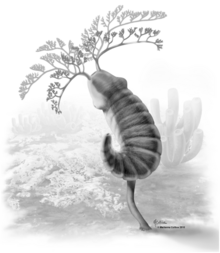Cambroernid
| Cambroernids Temporal range:
| |
|---|---|

| |
| Herpetogaster | |

| |
| Eldonia | |
| Scientific classification | |
| Domain: | Eukaryota |
| Kingdom: | Animalia |
| Stem group: | Ambulacraria |
| Clade: | †Cambroernida Caron, Conway Morris, & Shu, 2010 |
| Subdivisions | |
The cambroernids are a clade of unusual Paleozoic animals with coiled bodies and filamentous tentacles. They include a number of early to middle Paleozoic (Cambrian to Devonian)[1] genera noted as "bizarre" or "orphan" taxa, meaning that their affinities with other animals, living or extinct, have long been uncertain. While initially defined as an "informal stem group,"[2] later work with better-preserved fossils has strengthened the argument for Cambroernida as a monophyletic clade.[3]
One leading hypothesis is that cambroernids were unusual ambulacrarian deuterostomes, related to echinoderms and hemichordates.[2] Previously some cambroernids were compared to members of the broad invertebrate clade Lophotrochozoa; in particularly they were allied with lophophorates, a subset of lophotrochozoans bearing ciliated tentacles known as lophophores.[4] However, this interpretation has more recently been considered unlikely relative to the deuterostome hypothesis for cambroernid origins.[2]
Cambroernids encompass three particular types of enigmatic animals first appearing in the Cambrian: Herpetogaster (the type genus), Phlogites, and the eldoniids. They are united by a set of common features including at least one pair of bifurcated or divided oral tentacles, and a large stomach and narrower intestine enclosed together in a coiled sac. Herpetogaster has a segmented and clockwise-curved body attached to the substrate via a narrow and partially mobile stolon (stalk). Phlogites was even more simple, with a thick immobile stolon leading up to a tentacle-bearing calyx (cup-shaped main body). The eldoniids[2][5] (also known as eldonioids[4][6][7] or eldonids[1][6]) were diverse and disc-shaped, commonly described as "medusiform", i.e. jellyfish-shaped. Though the lifestyle of eldoniids is still debated, it can be agreed that they had a large curved stomach and no stolon.[4][2][8][6]
References[edit]
- ^ a b Hagadorn, James W.; Allmon, Warren D. (2019-01-01). "Paleobiology of a three-dimensionally preserved paropsonemid from the Devonian of New York". Palaeogeography, Palaeoclimatology, Palaeoecology. Studies in Honor of Prof. David J. Bottjer. 513: 208–214. Bibcode:2019PPP...513..208H. doi:10.1016/j.palaeo.2018.08.007. ISSN 0031-0182. S2CID 133683311.
- ^ a b c d e Caron, J.; Conway Morris, S.; Shu, D.; Soares, D. (2010). Soares, Daphne (ed.). "Tentaculate fossils from the Cambrian of Canada (British Columbia) and China (Yunnan) interpreted as primitive deuterostomes". PLOS ONE. 5 (3): e9586. Bibcode:2010PLoSO...5.9586C. doi:10.1371/journal.pone.0009586. PMC 2833208. PMID 20221405.
- ^ Li, Yujing; Dunn, Frances S.; Murdock, Duncan J.E.; Guo, Jin; Rahman, Imran A.; Cong, Peiyun (May 10, 2023). "Cambrian stem-group ambulacrarians and the nature of the ancestral deuterostome". Current Biology. doi:10.1016/j.cub.2023.04.048. PMID 37167976. S2CID 258592223. Retrieved 11 May 2023.
- ^ a b c Dzik, Jerzy; Yuanlong, Zhao; Maoyan, Zhu (1997). "Mode of life of the Middle Cambrian eldonioid lophophorate Rotadiscus" (PDF). Palaeontology. 40 (2): 385–396.
- ^ Zhu, Mao-Yan; Zhao, Yuan-Long; Chen, Jun-Yuan (2002-03-01). "Revision of the Cambrian discoidal animals Stellostomites eumorphus and Pararotadiscus guizhouensis from South China". Geobios. 35 (2): 165–185. Bibcode:2002Geobi..35..165Z. doi:10.1016/S0016-6995(02)00025-6. ISSN 0016-6995.
- ^ a b c Lefebvre, Bertrand; Van Roy, Peter; Zamora, Samuel; Gutiérrez-Marco, Juan Carlos; Nohejlová, Martina (2022-03-31). "The Late Ordovician Tafilalt Biota, Anti-Atlas, Morocco: a high-latitude perspective on the GOBE". Geological Society, London, Special Publications. 485 (1): 5–35. Bibcode:2022GSLSP.485....5L. doi:10.1144/sp485-2022-29. ISSN 0305-8719. S2CID 247351043.
- ^ Chen, Jun-yuan; Zhu, Mao-yan; Zhou, Gui-qing (1995). "The Early Cambrian medusiform metazoan Eldonia from the Chenjiang Lagerstätte" (PDF). Acta Palaeontologica Polonica. 40 (3): 213–244.
- ^ MacGabhann, Breandán Anraoi; Murray, John (2010). "Non-mineralised discoidal fossils from the Ordovician Bardahessiagh Formation, Co. Tyrone, Ireland". Irish Journal of Earth Sciences. 28: 1–12. doi:10.3318/IJES.2010.28.1. hdl:10395/2407. JSTOR 25780702. S2CID 129593969.
